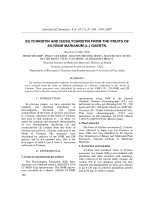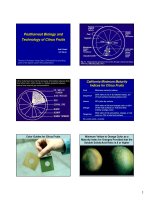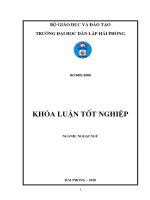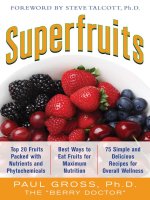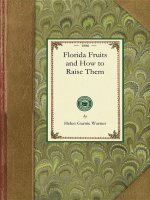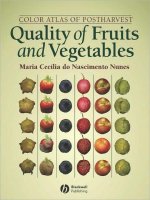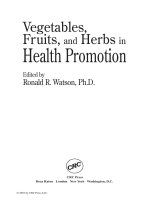Fruits and seeds
Bạn đang xem bản rút gọn của tài liệu. Xem và tải ngay bản đầy đủ của tài liệu tại đây (986.44 KB, 60 trang )
FRUITS AND SEEDS
Fruits
❚ Part of sexual reproduction unique to
angiosperms
❚ Develops from fertilized ovary
❚ Protect the enclosed seeds and aids in
seed dispersal
❚ Widely utilized as a significant food source
Fruit wall or Pericar p
❚ Develops from the ovary wall
❚ Composed of three layers
❙ outer exocarp
❙ middle mesocarp
❙ inner endocarp
❚ Appearance of these three layers varies
among different fruit types
Fruit Types I: Simple Fruits
❚ Derived from the ovary of a single carpel
or several fused carpels
❚ Can be fleshy or dry
Type I.a: Simple fleshy fruit
❚ Derived from the ovary of a single carpel or
several fused carpels
❚ Often soft and juicy
❚ Seed dispersal occurs when an animal eats
the fruit
❚ Types of simple fleshy fruits
❙ BERRY
❙ DRUPE
-HESPERIDIUM
-POME
-PEPO
Ber r y
❚ Thin exocarp
❚ Soft fleshy mesocarp
❚ Endocarp with one to
many seeds
❚ Tomatoes, grapes
and dates
Hesperidium
❚ Berry with a tough
leathery rind
❚ Oranges, lemons, and
other citrus fruitS
Pepo
❚ Tough outer rind that
has both receptacle
tissue and exocarp
❚ Mesocarp and
endocarp are fleshy
❚ All members of the
squash family
(pumpkins, melons,
and cucumbers)
Dr upe
❚ Thin exocarp
❚ Fleshy mesocarp
❚ Hard stony endocarp
which encases the
seed
❚ Cherries, peaches,
and plums
Exocarp
Mesocarp
Endocarp
Pome
❚ Fleshy part develops
from the enlarged
base of the perianth
(calyx and corolla)
that is fused to the
ovary wall
❚ Apples and pears
Accessor y fruits
❚ Contain flower parts other than the ovary
❚ Both the pepo and pome are example
Type I.b: Simple dry fruits
❚ Derived from the ovary of a single carpel
or several fused carpels
❚ Pericarp may be tough and woody or thin
and papery
❚ Two types:
❘ dehiscent
❘ indehiscent
Dr y dehiscent fruits
❚ Split open at maturity to release seeds
❚ Wind often aids seed dispersal
❚ Types characterized by how they open:
* Follicle - splits open along one seam (magnolia
and milkweed)
* Legume - splits open along two seams (beans and
peas)
* Capsule - several pores or slits (cotton and poppy)
Legume - pea
❚ Legume pod splits
along two seams to
disperse seeds
Capsule
❚ Cotton fruit is a
capsule splitting open
along five lines
❚ Seeds are covered
with long hairs
(trichomes) which are
the commercial
cotton fiber
Indehiscent fr u its
❚ Do not split open to release seeds
❚ Common types
❙
❙
❙
❙
Achene
Samara
Grain
Nut
ACHENES
SAMARAS
❚ One-seeded fruit
❚ Pericarp free from
the seed
❚ Sunflower “seeds”
❚ Winged achenes
❚ Dispersed by wind
❚ Fruit in maple trees
and ash trees
Grains
❚
❚
❚
❚
Also called caryopsis
Single seeded fruits
Pericarp fused to seed coat
Fruits of all cereal grasses: wheat, rice,
corn and barley
Wheat gr ain
Fused seed
coat and ovary
wall layers
Nuts
❚ One-seeded fruits
❚ Hard stony pericarps
❚ Hazelnuts, chestnuts,
and acorns
❚ Other things
commonly called nuts
that are not true nuts
but are actually seeds
Fruit Types II: Aggregate fruits
❚ Develop from a single flower with many
separate carpels
❚ Raspberries and blackberries
❚ Strawberries also contain accessory tissue
❙ Seeds on the surface are actually separate
achenes inserted on the enlarged, fleshy, red
receptacle
Raspberries and Blackberries
Aggre gate-Accessor y
Fruit
❚ Strawberries also
contain accessory
tissue
❚ Seeds on the surface
are actually separate
achenes on enlarged,
fleshy receptacle
Fruit Types III: Multiple fruits
❚ Result from the fusion
of ovaries from many
separate flowers on
an inflorescence
❚ Figs and pineapples
are examples of
multiple fruits
one of many ovaries that
are fused together
